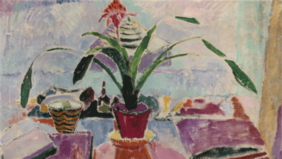Nazi-Looted Painting by Oskar Moll remains in the Schlesischen Museum in Görlitz Germany
Wednesday, February 5, 2025

A significant painting from the collection of the Silesian Museum in Görlitz has been identified as a work left behind by art collector Otto Wachenheim when fleeing Nazi persecution.
The artwork is now being returned to its rightful heirs but will remain accessible to the public thanks to a repurchase supported by the German federal government, the Saxon Ministry of Culture, and the Cultural Foundation of the German States.
The painting "Aechmea fasciata with Books and Centennial Hall [Untitled]" (1926) by artist Oskar Moll (1875–1947) was most likely owned by Otto Wachenheim, a Jewish art collector who fled to the USA in 1939, and is classified as Nazi-looted art. In accordance with the 1998 Washington Principles, an agreement was reached with Wachenheim's heirs. They receive compensation, while the painting remains part of the permanent exhibition of the Silesian Museum.
Minister of State for Culture Claudia Roth: "The painting 'Aechmea fasciata' by Oskar Moll uniquely reflects the Expressionist movement, a key era in German art history. Thanks to the generosity of the heirs, this painting remains publicly accessible. Germany is committed to continuing the restitution of Nazi-looted cultural assets and finding fair solutions to address past injustices. Therefore, the federal government was pleased to support this restitution and repurchase."
Saxon Minister for Culture and Tourism Barbara Klepsch: "Otto Wachenheim was forced to leave this still life behind under extreme persecution. By restituting it, we fulfill our historical responsibility. I thank everyone involved for ensuring the heirs are compensated while preserving this important painting for the Silesian Museum."
Prof. Dr. Markus Hilgert, Secretary General of the Cultural Foundation of the German States: "For over 25 years, our foundation has supported institutions in implementing fair solutions under the Washington Principles. I am pleased that we reached a good agreement with the Wachenheim heirs, allowing Oskar Moll’s painting to remain accessible to the public in Görlitz. This is the ideal place to contextualize the work within German-Polish history."
Dr. Imke Gielen, attorney for the heirs: "On behalf of the Wachenheim and Herbst families, we welcome this restitution. It is significant to them as it acknowledges and partially remedies the injustice suffered by their great-uncle and great-great-uncle during the Nazi era. The families thank the Silesian Museum in Görlitz for its trust and commitment to provenance research."
Otto Wachenheim (1885–1969) was born in Mannheim and lived in the Netherlands from 1923 until his emigration to the USA in 1939. His wealth, including an art collection of Impressionist and Modernist works, remained in his Amsterdam home, which was occupied by the German authorities after 1940. When they vacated the house, furniture and artworks disappeared, likely in 1944. After WWII, Wachenheim unsuccessfully tried to recover his lost collection. His description of a "book still life" was registered in the "Lost Art" database in 2009, leading to the identification of Moll's painting in Görlitz.
Oskar Moll (1875–1947) was a prominent figure in Breslau Modernism. Born in Brieg (Brzeg), Silesia, he studied in Munich and Berlin under Lovis Corinth and was later influenced by Henri Matisse in Paris. He became a professor at the Academy of Arts and Crafts in Breslau (Wrocław) in 1918 and served as its director from 1925. After the academy closed in 1932, he moved to Düsseldorf but was labeled a "degenerate artist" by the Nazis in 1933. He passed away in Berlin in 1947.
Main Image: Oskar Moll, „Aechmea fasciata mit Büchern und Jahrhunderthalle [o. T.]“, 1926, Öl auf Leinen, Schlesisches Museum zu Görlitz, Inv.-Nr. SMG 2001/1900. Foto © SMG
